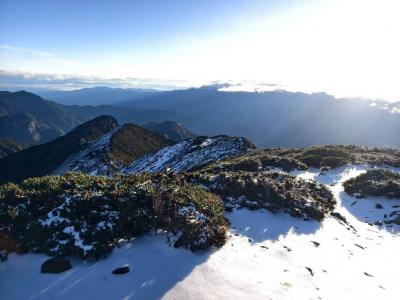
The Shei-Pa National Park Headquarters today announced guidelines for hikers seeking to do one-day climbs in Hsuehshan (雪山) to avoid becoming stranded or requiring rescue resources. A one-day round trip for Hsuehshan takes about 14 hours, covers 22km and has an elevation difference of 3,500m, the agency said, adding that it can be complicated by weather conditions or illness. Hikers who do not reach Sanlioujiou Cabin (三六九山莊) by 11am are recommended to not continue their climb, return to the trailhead and avoid moving in the dark, it said. This is not only for their own safety, but also to reduce the use of rescue resources, it said. There are eight main climbing routes throughout the park, of which the main Hsuehshan route is the most popular. Statistics from the headquarters show that 31,547 people have been approved to climb Hsuehshan in the past three years, with 3,000 one-day trips each year. The climb requires physical fitness, the headquarters said, adding that the rapid ascent in altitude can also cause altitude sickness. The afternoon can also bring thick fog or heavy rain, which makes following the path more difficult, it said. Steep ascents and descents in a short period of time also use a lot of energy, leading to slower responses to emergency situations, and any delays could result in needing to descend after sunset, the headquarters said. Management at Sanlioujiou and Cika (七卡山莊) cabins would be asked to remind hikers of the dangers associated with one-day climbs, it said. Those who attempt one-day hikes must cooperate with inspections and listen to instructions or guidance from cabin management, the headquarters said. Those who ignore guidance and go on to cause incidents on the mountain that affect the safety of the park or waste rescue resources would be punished according to the National Park Law (國家公園法) and local authorities would be asked to
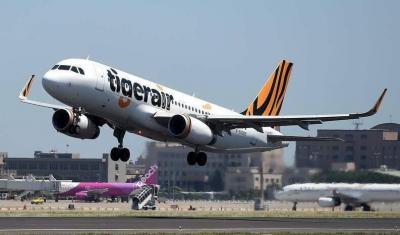
Tigerair Taiwan is to launch three new international routes, two to South Korea's Jeju Island and one to Japan's Ishigaki Island, starting late this month as summer vacation nears. The Kaohsiung-Jeju route is to begin on June 30, followed by Taichung-Jeju on July 1 and Taoyuan-Ishigaki on July 17, the Taiwan-based low-cost carrier said in a statement today. With the additions, Tigerair Taiwan is to become the first domestic carrier to offer direct flights to Jeju from northern, central and southern Taiwan. The Ishigaki route is to also bring the number of Japanese destinations served by the airline to 23, the statement said. The Kaohsiung-Jeju and Taoyuan-Ishigaki routes are new, while the Taichung-Jeju route has been operated in the past, the airline said. Tigerair plans to operate four weekly flights on the Kaohsiung-Jeju route, and two per week on each of the other two routes, with adjustments possible based on demand. Base fares for the Jeju routes start at NT$500, while those for the Taoyuan-Ishigaki route would start at NT$1,599 during a promotion on Wednesday and Thursday, the airline said.
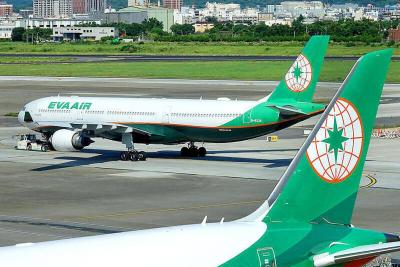
EVA Airways Corp (長榮航空) has announced a codeshare agreement with fellow Star Alliance member LOT Polish Airlines, with the deal to take effect on Monday. The agreement includes EVA’s flights between Taiwan Taoyuan International Airport and Tokyo’s Narita Airport and Taoyuan-Vienna, as well as a Warsaw-Vienna route operated by LOT, EVA Air’s first expansion to Warsaw. Since joining the Star Alliance in 2013, EVA has been committed to deepening cooperation with other alliance members and the codeshare agreement with LOT is a major step in that process, EVA executive vice president Liao Chi-wei (廖至維) said in a statement. The agreement not only makes travel between Taiwan and Poland easier, it also promotes bilateral tourism, trade and friendly relations between both countries, Liao said. Although there have been no direct flights between the two countries since an air traffic agreement was inked in 2015, Taiwan has grown closer to European countries and sought opportunities to cooperate, the statement said. The deal lays a key milestone for EVA to continue building its eastern European network, it said, adding that, hopefully, more connections between Warsaw and Taoyuan would be added. There are daily flights between Taoyuan airport and Vienna, with seamless transfers in Vienna to LOT’s daily Warsaw flights, it said. People in Poland would be able to take flights from Warsaw to Vienna and transfer for EVA flights to reach Taipei or Tokyo, it added. As Taiwan’s semiconductor supply chain continues to expand internationally, central and eastern Europe is becoming an area of focus, it said. The codeshare agreement would allow for greater ties between Taiwan and the region, help develop more European routes, and enhance EVA’s competitiveness and visibility in Europe, it said.
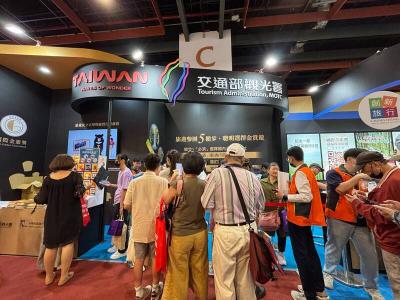
The government is to promote good tourism infrastructure in a push to attract visitors, in addition to expanding the labor pool with foreign workers, Premier Cho Jung-tai (卓榮泰) said today. The only way to attract international visitors is to invest in good transportation infrastructure, Cho said at the Taipei Tourism Expo, which runs from today to Monday at the Taipei World Trade Center. This year's expo has a record-high 350 participating companies, nearly 40 percent more than last year, organizers said. Taiwan's national development has been negatively impacted by US tariff and trade policy, making it even more important to invest in attracting visitors, as the “movement of people remains tariff-free,” Cho said. As part of this strategy, the government next year plans to expand domestic demand in addition to attracting international tourists, he said. This includes investing in good tourism infrastructure, as it is the best way to entice international visitors, Cho added. To bring international tourists to Taiwan, the government would provide subsidies to lower travel barriers, such as language training, to ensure the nation has a positive image abroad and balance the number of outgoing travelers with incoming ones, Cho said. The government would also combine large events such as international exhibitions, sporting events and concerts into tourism packages, he said. Regarding labor, the government plans to introduce new policies that still prioritize local workers, but also introduce migrant workers to meet demand, Cho said. Customs and immigration procedures would also be optimized, he added. The expo is Taiwan's largest travel fair in the first half of the year, and is estimated to attract 300,000 people. It features more than 20 central and local government agencies in addition to travel agencies, airlines, hotels and overseas tourism operators.

A section of railway blocked by a landslide in Hualien County reopened to two-way traffic along the eastern track this morning, with both tracks expected to reopen by Saturday, Taiwan Railway Corp (TRC) said. Heavy rains on Sunday and yesterday triggered landslides that left debris on the Chongde-Renhe section of the eastern rail line and damaged electrical equipment. Rail traffic in both directions was halted on Monday, with the state-run company offering shuttle services bypassing the affected area. Thanks to the hard work of 40 repairers, the eastern track was cleared by 4:20am today and reopened to two-way traffic at 5:36am, the TRC said in a news release. The first train, local No. 4117, departed from Chongde Station at 5:43am, it said. Workers were still clearing debris from the western track, and were expected to finish by later today, it said. The entire western track is expected to be repaired by Saturday at the earliest, it added. Additional reporting by CNA
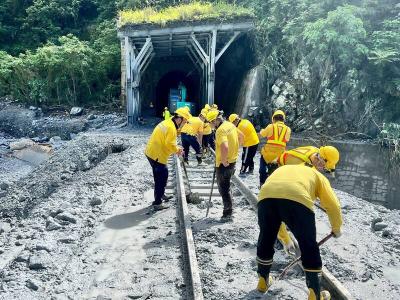
The Chongde-Renhe section of Taiwan Railway's line along eastern Taiwan was closed to traffic in both directions yesterday, after landslides caused by heavy rain in Hualien County swept soil over the tracks. Taiwan Railway Corp said it has dispatched workers and vehicles to the site and repair work began at 7pm yesterday. Train schedules would continue to be adjusted until 6pm today, the state-run company said. Southbound reserved-seat trains originating in the greater Taipei area were operating only as far as Su'aoxin Station in Yilan County, while local trains were running to Heping Station in Hualien County, it said. All northbound trains were terminating at Hualien Station, it said. Shuttle bus services between Hualien and Heping began at 7:30pm yesterday to help people get to destinations between those two areas, and the number of shuttle buses would be adjusted flexibly based on real-time weather information, the company said.
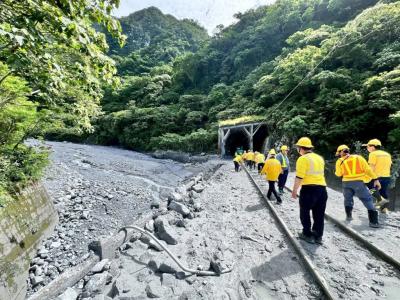
Single-track service along the Chongde-Renhe section of Taiwan Railway’s line along eastern Taiwan is expected to resume on Wednesday, and dual-track service on Saturday after landslides caused by heavy rain damaged the tracks. Flooding inside the tunnel is more severe than expected, Taiwan Railway Corp (TRC) told a news conference this afternoon. It would take about four days to fully repair the damage, TRC deputy general manager Chen Tsung-hung (陳宗宏) said. The TRC’s early warning system was effective, promptly notifying trains along the route to stop via the operations control center, Chen said. Shuttle bus services from Xincheng to Heping began at 5:32am this morning and as of 2pm had made a total of 17 trips transporting 8,360 passengers, he said. Shuttle bus services from Hualien to Heping are to run from 8pm to midnight tonight, with the frequency to be adjusted based on the weather, he added. In a later news release, the TRC said that about 200m of track were damaged and 60 sleepers were broken, with about 3,000m³ of debris covering the tracks. In addition, about 300m of the electric traction system’s wires were damaged, and one electric power pole was toppled over, it said. About 300m of signaling and communication cables and main power cables were damaged, and one set of radio repeaters was destroyed, it added.
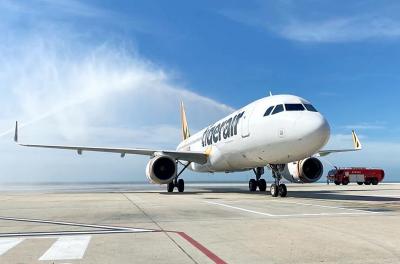
Tigerair Taiwan today announced it would launch a new route in July between Kaohsiung and Sendai, Japan. The service would initially operate three times a week, with flight IT-772 departing from Kaohsiung International Airport every Monday, Wednesday and Saturday at 1:25pm, the China Airlines subsidiary said in a news release. The return flight, IT-773, would depart from Sendai on the same days at 7pm, said the airline, Taiwan's only budget carrier. Tickets for flights on the new route would go on sale tomorrow at discounted rates on the Tigerair Taiwan Web site, it said. The new service would be the airline's 11th international route departing from Kaohsiung, after Sapporo, Tokyo’s Narita Airport, Nagoya, Osaka, Okayama and Okinawa in Japan; Seoul’s Gimpo Airport; Macau; and Da Nang, Vietnam. Japan is the most popular destination of Taiwanese travelers, tourism data showed. Last year, about 6 million Taiwanese travelers visited Japan, making it the top foreign destination, followed by 2.77 million to China and 1.43 million to South Korea, Tourism Administration data showed.

United Airlines today launched its new Taipei (Taoyuan)-Guam route, offering twice-weekly flights, while Tigerair Taiwan inaugurated its Taipei (Taoyuan)-Oita service also flying twice a week. United Airlines operates the new route using a Boeing 737-800 with 166 seats. Departures from Taiwan Taoyuan International Airport are scheduled for 10:30am on Wednesdays and 11am on Saturdays, while return flights from Guam leave at 7am on both days. To mark the inaugural flight, representatives from the Guam Visitors Bureau and United Airlines visited Taiwan today. At the Taoyuan airport, they emphasized their joint efforts to promote Guam as a travel destination. Kenichi Kiriyama, United Airlines' director of sales for Japan, Micronesia, the Philippines and Taiwan, highlighted the airline's long-standing presence in Taiwan since 1986. Since 2014, the US carrier has transported 2 million passengers between Taoyuan and San Francisco, he said, adding that in addition to the Taipei-Guam route, the airline plans to launch flights from Kaohsiung to Tokyo on July 12. Meanwhile, Tigerair Taiwan's new Taipei-Oita route makes Oita its 21st destination in Japan and its fourth direct flight to Kyushu, following Fukuoka, Saga and Miyazaki. The Taipei-Oita service operates twice weekly, with outbound flights departing at 12pm on Wednesdays and Saturdays, and return flights from Oita leaving at 4:30pm the same days, the low-cost airline said.

Heavy traffic is expected on various sections of Taiwan's provincial highways during the four-day Tomb Sweeping Festival holiday that starts on Thursday and ends on Sunday, the Highway Bureau said today. Motorists are advised to stay informed of traffic conditions beforehand, avoid peak hours and congested roads, the bureau said in a news release. Congestion is expected on Provincial Highway No. 9 between Suao (蘇澳) in Yilan County and Hualien City during different time periods, most notably on southbound lanes from 3am to 5pm on Thursday, and from 8am to 10am on Friday, it said. Traffic on the highway's northbound lanes is forecast to pick up from 2pm to 7pm on Saturday, and from 1pm to 4pm on Sunday, the bureau added. Motorists traveling between Taitung and Pingtung counties can also expect to see congestion on the No. 9 highway's northbound and southbound lanes during various hours from Thursday to Saturday. In Pingtung County, the bureau anticipates heavy traffic on a section of Provincial Highway No. 1 between Shuidiliao (水底寮) in Fangliao Township (枋寮) and Fenggang (楓港) in Fangshan Township (枋山) during the first three days of the holiday. Meanwhile, congestion is forecast to occur at different hours along various sections of Provincial Highway No. 61, also known as the West Coast Expressway, which runs from New Taipei City to Tainan. Citing an example, the bureau said heavy traffic is expected on sections near Miaoli County and Taichung due to reconstruction work being carried out on two road bridges. In the news release, the bureau also listed other roads that could see potential traffic during the holiday, including Provincial Highways No. 64 and No. 65, both in New Taipei City. Furthermore, motorists are advised to be aware of congestion on roads leading to various scenic destinations, such as the section between Fulong (福隆) and Wanli (萬里) in New Taipei

On the final approach to Lanshan Workstation (嵐山工作站), logging trains crossed one last gully over a dramatic double bridge, taking the left line to enter the locomotive shed or the right line to continue straight through, heading deeper into the Central Mountains. Today, hikers have to scramble down a steep slope into this gully and pass underneath the rails, still hanging eerily in the air even after the bridge’s supports collapsed long ago. It is the final — but not the most dangerous — challenge of a tough two-day hike in. Back when logging was still underway, it was a quick, easy ride up from Hualien City via a series of cableways and railways. Nowadays, hikers must take an alternative route along a ridge, only descending to the railway after the last impassable obstacle for the final two kilometers. Once you finally make it to Lanshan Workstation, it is worth sticking around for at least a half-day if not a full day. The sheer size of the place and the number of buildings still standing are enough to keep you busy exploring for hours. WORKING LIFE Along the main tracks as you walk in are the buildings where people did their work at Lanshan. On the left are three partially collapsed buildings — the locomotive shed, the power plant and the lumber processing station — and a still-intact fueling station. Several locomotives are scattered in and around these buildings, still sitting on the rails where they were parked on their last working day back in 1989. Less than four meters long, with their cabs covered in flaking yellow paint and the rest in a layer of moss, these tiny logging locomotives are among the most photogenic relics at Lanshan today. A little further ahead are some of the best-preserved buildings at the site. On the
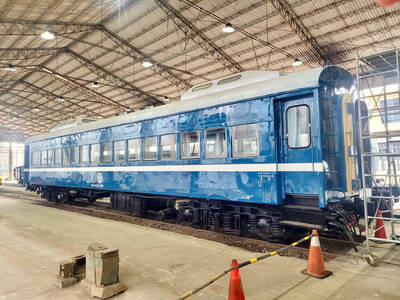
For decades, Taiwan Railway trains were built and serviced at the Taipei Railway Workshop, originally built on a flat piece of land far from the city center. As the city grew up around it, however, space became limited, flooding became more commonplace and the noise and air pollution from the workshop started to affect more and more people. Between 2011 and 2013, the workshop was moved to Taoyuan and the Taipei location was retired. Work on preserving this cultural asset began immediately and we now have a unique opportunity to see the birth of a museum. The Preparatory Office of National Railway Museum is responsible for restoring — or simply preserving — the workshop grounds and opening them up to the public. The only part regularly open at the moment is the employee bathhouse. With its exhibits and interior restoration, it feels more museum-like than the rest of the grounds, where the piles of disused equipment, tools and materials, as well as the smell of steel and oil, make it seem more like a working factory where the employees just happen to have the day off. This part needs to be cleaned up and made safer before it can be opened to the public on a regular basis, but occasional guided tours do allow a glimpse into this space as it is now. THE BATHHOUSE Visitors enter the museum through the west wing of the employee bathhouse. This was the earliest part of the Taipei Railway Workshop to be designated as a historic site, for both its architectural and its cultural significance, back in 2000 when the workshop was still in use. This wing features an exhibit on art deco style buildings throughout Taiwan from the 1930s. The bathhouse itself was built in this decade and in this style, so the exhibit serves to place
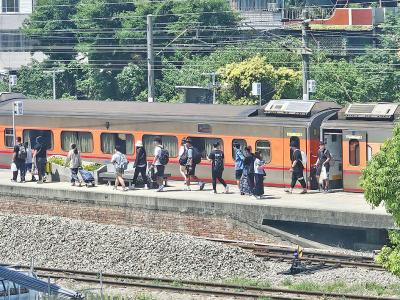
Taiwan railway ticket prices may increase for the first time in 30 years, as the Taiwan Railway Corp (TRC) is proposing an average fare increase of 26.8 percent to its board of directors this afternoon. According to the Legislative Yuan, a reasonable rate of return for TRC ticket revenue is 3 to 5 percent. However, critics have raised concern that this rate would cause ticket prices to rise too much, significantly impacting the public. The TRC plans to set the return rate at no lower than 0.36 percent, with the average fare to be increased by 26.8 percent. The company said it plans to adjust fares proportionally based on distance traveled, with short-distance fares increasing more and long-distance fares increasing less. For example, the fare for the Tze-Chiang Limited Express between Taipei and Kaohsiung would increase from NT$824 to NT$975. Meanwhile, the fare for the Tze-Chiang express from Taichung to Taipei would increase from NT$375 to NT$501. A local train from Taipei to Banciao District (板橋) would cost NT$22, while the Tze-Chiang express for the same journey would cost NT$34. A local train from Taipei to Hualien would increase from NT$283 to NT$375, and the Tze-Chiang express for the same journey would increase from NT$440 to NT$583. An announcement would be made if the fare adjustment plan is approved by the board of directors this afternoon, TRC chairman Du Wei (杜微) said. The plan would be designed with three key considerations: affordability for short-distance passengers, competitiveness for medium-distance routes and retention of long-distance passengers, Du said.
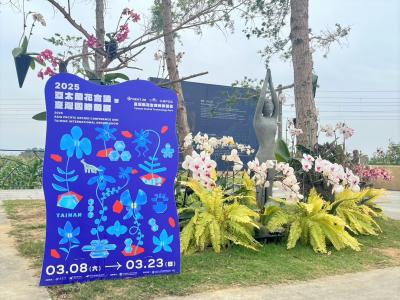
This year’s Asia Pacific Orchid Conference and Taiwan International Orchid Show are to run from March 8 to 23 at the Taiwan Orchid Technology Park in Tainan’s Houbi District (後壁). The conference host rotates between different member cities in the Asia-Pacific region every three years and is to return to Tainan for its 15th edition for the first time since 2004. The event is to coincide with the Taiwan International Orchid Show in Tainan's Sibei Township (溪北), Tainan Mayor Huang Wei-che (黃偉哲) said. The joint event would not only showcase the diversity and conservation of orchids, but hollyhocks, Mexican lilacs, the red silk cotton tree, the orchid tree, the pink shower tree, the chinaberry tree and the pink trumpet tree would also be in bloom, he said, welcoming flower enthusiasts to visit Tainan to experience the beauty of this year’s blossom season. The event would also display innovative floriculture designs and host lectures from experts, networking events and interactive experiences, the Tainan Tourism Bureau said. The orchid show is to be hosted in Houbi, with the main event at Taiwan Orchid Technology Park. Two satellite locations, the Arwin Therapy Garden which opened last year and the century-old Yichang Rice Mill with its historic Jingliao Old Street, are to serve as additional orchid display sites. Presale tickets are available now, currently priced at NT$200. Ticketing information can be found on the event’s Web site.
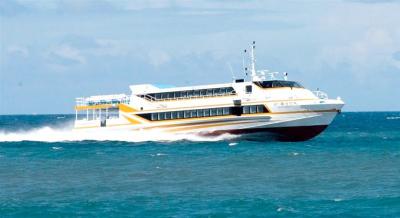
Ferry operators are planning to provide a total of 1,429 journeys between Taiwan proper and its offshore islands to meet increased travel demand during the upcoming Lunar New Year holiday, the Maritime and Port Bureau said yesterday. The available number of ferry journeys on eight routes from Saturday next week to Feb. 2 is expected to meet a maximum transport capacity of 289,414 passengers, the bureau said in a news release. Meanwhile, a total of 396 journeys on the "small three links," which are direct ferries connecting Taiwan's Kinmen and Lienchiang counties with China's Fujian Province, are also being planned to accommodate travel needs during the nine-day holiday. During the Jan. 25 to Feb. 2 period, should any adverse weather or other force majeure affect ferry services, operators are required to publicly announce the information through various media platforms, the bureau said, adding that it would also provide real-time updates on ferry schedules on its official Web site. Separately yesterday, Taoyuan International Airport Corp said that flight passenger traffic is expected to peak starting on Monday next week as the Lunar New Year holiday approaches. During the longest holiday of the year, Feb. 2 (the fifth day of the Lunar New Year and the day before work resumes) is anticipated to see the highest travel volume, with nearly 150,000 passengers, the company said in a statement. As such, a total of 14 chartered flights and 103 extra flights would be added to serve more than 1.59 million passengers during the 11-day period from Friday next week to Feb. 3, the company said.
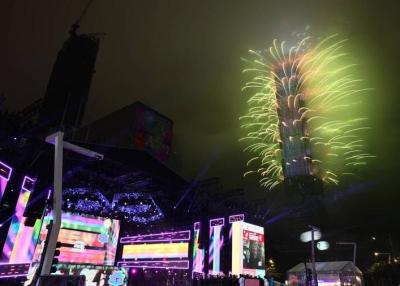
The Taipei MRT is open all night tonight following New Year’s Eve festivities, and is offering free rides from nearby Green Line stations. Taipei’s 2025 New Year’s Eve celebrations kick off at Taipei City Hall Square tonight, with performances from the boy band Energy, the South Korean girl group Apink, and singers Gigi Leung (梁詠琪) and Faith Yang (楊乃文). Taipei 101’s annual New Year’s firework display follows at midnight, themed around Taiwan’s Premier12 baseball championship. Estimates say there will be about 200,000 people in attendance, which is more than usual as this year’s celebrations overlap with A-mei’s (張惠妹) concert at Taipei Dome. There are three shuttle buses in the area heading toward MRT stations that run from midnight to 1:30am. The first leaves from the Renai Road and Yanji Street intersection, heading toward Taipei Railway Station. The second leaves from the Guangfu S Road and Wenchang Street intersection next to Keelung Road Sec 2, heading toward Gongguan Station. The third leaves from the Songde Road and Xinyi Road Sec 6 intersection, heading toward Jingmei and Muzha stations. There is one more shuttle bus running from midnight to 2am that leaves from the Guangfu S Road and Zhongxiao E Road intersection, heading toward Nanjing Sanmin Station. The Taipei MRT runs for 24 hours on New Year’s Day, except for the Xiaobitan and Xinbeitou lines, which close at midnight. As most people took the Blue and Red lines in previous years, it is recommended to walk or take a shuttle bus to Nanjing Sanmin or Taipei Arena stations to take the Green Line. Catching the Green Line from either of those stations is free from midnight to 6am. The Taoyuan MRT is to run for 41 consecutive hours from 6am today to 11pm tomorrow. Starting from 5pm today, 33 YouBike stations in the Xinyi area are to be closed, with 22 more stations closing

One of my more inexplicable ambitions is to board or alight from a train at every one of the 240 Taiwan Railway Corp stations that offer passenger services. I reckon I’ve still got over 100 to go, but if I live to a ripe old age, I might complete the list. Anyhow, this means that when I took a train to Luye Township (鹿野) in Taitung County a few weeks ago, I felt as if I’d accomplished something as soon as I’d passed the ticket gate. The station is less than 100m east of Highway 9, whereas the most interesting parts of the township lie to the west of this busy road. Rather than rent a bike, which is what many visitors do, I decided to hoof it. Having been there a few times before, I had no interest in going up to Luye Highland (鹿野高台), one of Taiwan’s premier paragliding and ballooning venues. Instead, I wanted to take a proper look at Longtian Village (龍田村), immediately south of the highland. COLONIAL ERA Longtian’s road grid was laid out 1912-1915 by Taiwan Sugar Company (not the current state-owned Taiwan Sugar Corp, but a Japanese-owned sugar enterprise active during the 1895-1945 period of colonial rule). The company was acting at the behest of the colonial authorities, who’d been directed by their masters in Tokyo to prepare sites for the arrival of migrants from Japan’s Home Islands. In the early 20th century, as the country industrialized, the simultaneous mechanization of Japanese agriculture caused rural unemployment. The government decided that sending some of the jobless and landless to Taiwan would reduce the risk of unrest at home while strengthening Tokyo’s hold over a colony where armed resistance was an ongoing problem. The designated settlers’ villages were all in the east, and none of them lived up to
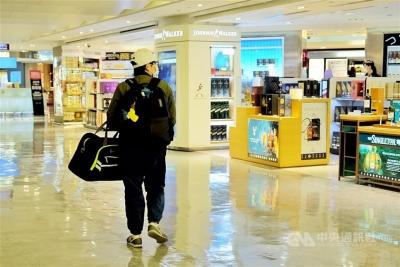
The Ministry of Finance said it is planning to increase the allowance for duty-free alcohol brought into the country by travelers for their personal use from the current 1 liter to 1.5 liters. When the regulation is changed, it would take effect in the first quarter of next year, a ministry official said recently. Currently, the allowance for duty-free alcohol for personal use is 1 liter per incoming traveler, with no limit on the number of bottles and no requirement for customs declaration. Passengers who exceed the duty-free limit must declare the alcohol, otherwise they risk confiscation and fines at customs, according to the current regulations. The ministry is now planning to increase the duty-free allowance, taking into account the relevant regulations in other countries, tax implications, and opinions in Taiwan's alcohol and import industries, the official said. According to a recent Customs Administration survey, the duty-free allowance for alcohol in Thailand, Indonesia, Hong Kong and Macau is 1 liter per inbound passenger, while in China it is 1.5 liters, and in South Korea and Singapore it is 2 liters. In Vietnam, the duty-free limit is 1.5 to 3 liters, depending on the alcohol percentage, while Japan allows three bottles of less than 760ml each, which is about 2.28 liters in total. In the US and Australia, the duty-free allowance for alcohol is 1 liter and 2.25 liters respectively. The UK allows incoming travelers to bring in a maximum 42 liters of duty-free beer and 18 liters of grape wine. If Taiwan raises its duty-free limit for alcohol to 1.5 liters, the total tariffs, business taxes, and tobacco and alcohol taxes would drop by millions of New Taiwan dollars per year, the ministry said, citing an estimate of 12 million incoming travelers annually. The ministry official said it had been considering increasing the duty-free allowance to 2 liters, but
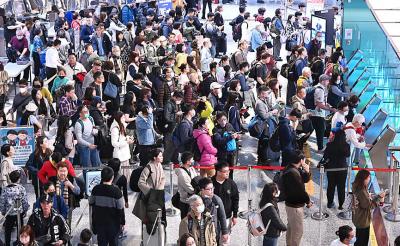
The Ministry of Transportation and Communications (MOTC) is to continue to promote tourism to transit passengers at Taiwan Taoyuan International Airport by offering a limited number of guided group tours to the Taoyuan Lantern Festival in February, it said today. The Taoyuan airport last year received a record number of transit passengers at 6.37 million, constituting 12.5 percent of all passenger traffic, the ministry said. The Legislative Yuan’s Transportation Committee invited the ministry to give a specified report on how to travel experiences for transit passengers. According to the report, pre-COVID-19-pandemic arrivals to Taoyuan airport were 48.7 million, with 5.65 million transit and layover passengers constituting about 10 percent. However, once national lockdowns were lifted last year, transit and layover passengers increased by 13 percent from pre-pandemic levels, comprising 12.5 percent of overall passenger volume, the ministry said. The highest percentage of transit passengers last year were from North America, at 39.8 percent, followed by Southeast Asia and South Asia at 36.9 percent and East Asia at 7.1 percent, showing the importance of the Taoyuan airport as an international transport hub for passengers traveling between North America and Southeast Asia, it said. The Tourism Administration has previously targeted passengers with a layover in Taiwan between seven and 24 hours and holding visas or visa exemptions for half-day tourism packages. It offers four-hour guided group tours to Taipei, Taoyuan or New Taipei City, as well as Taoyuan Metro tickets and travel recommendations to independent tourists, the MOTC said. From May last year until last month, 14,692 international transfer passengers utilized the scheme, with 60 percent, or 8,807 passengers, choosing group tours and 40 percent, or 5,885 passengers, choosing independent travel, it said, adding that most came from the US, Canada, the Philippines, Germany and Australia. Special day and night tours would also be offered for transit
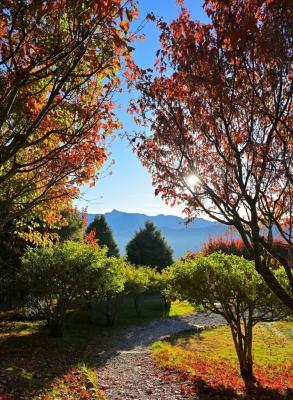
The peak season for viewing maple tree foliage in the Alishan National Forest Recreation Area is to last from now until New Year's Day, Forestry Bureau officials said today. The officials from the Chiayi branch of the bureau said that the approaching cold air mass was expected to help the maple foliage continue to transform into spectacular colors. The best areas include the Ogasawara Viewing Platform (小笠原觀景平台), Ciyun Temple (慈雲寺), Zhaoping Station (沼平) and Duigaoyue Station (對高岳), they said. They said that about half of the maple foliage visible from the Ogasawara Platform has turned red, while the maples near Zhaoping and Duigaoyue stations are about 40 percent red. At Ciyun Temple, the green maples have just begun to change and about 10 percent have red hues, they said. Huang Yuan-ming (黃源明), a retired elementary teacher devoted to documenting Alishan's beauty, said on his "Alishan: Strolling Above the Clouds" Facebook page that as well as the trees in the forest park, the green maples along the Shizilu section of Taiwan Provincial Highway No. 18 are a sight to behold. "From the 79k tunnel to the 83.5k section, the roadside green maples are beautifully vibrant," he wrote. Huang added that in the 88k and 90.8k sections, the trident maples are changing daily, showcasing shades of yellow, green and red. Additionally, the maple trees along Highway No. 18 between Alishan and Tataka have already turned red, he said.
